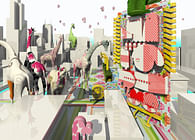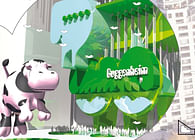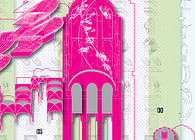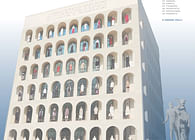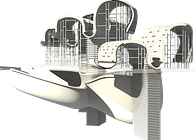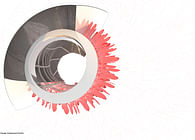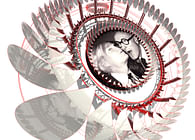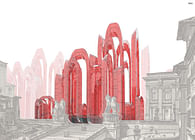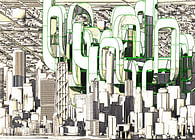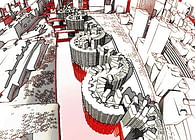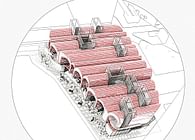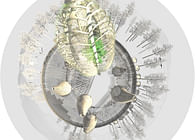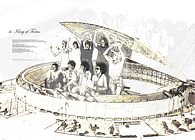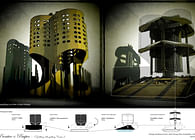
Lucas’s Labyrinth
The Lucas Museum will symbolically act as an analogy of a labyrinth. The recurring themes of George Lucas’s work directly coincides with the labyrinth in the form of a monomyth. The dual experience of both inner and outer paths of the labyrinth will complete themselves as visitors return home from the Lucas Museum with the gift of the hero’s journey. This gift contains an understanding similar to any personal journey, and what is required and sacrificed to complete it. Both the risk and the reward of Lucas’s heroes are now physically represented as an iconic architectural symbol in the museum which bears his name, exhibits his collections and furthermore educates new generations of storytellers.
“A hero ventures forth from the world of common day into a region of supernatural wonder: fabulous forces are there encountered and a decisive victory is won: the hero comes back from this mysterious adventure with the power to bestow boons on his fellow man.”
The Hero with a Thousand Faces - Joseph Campbell
Campbell explored the theory that important myths from around the world have survived for thousands of years all sharing a fundamental structure, which he called the monomyth. In many interviews, George Lucas has confirmed Campbell's work as a direct influence upon the creation of all the Star Wars films.
Labyrinths :
The Lucas Museum is a series of labyrinth-like structures on the lakefront in the city of Chicago. The labyrinth-like structures represent elements of George Lucas’s personal and professional pursuits contained within an institutional campus. The institutional campus of the museum is programmatically constructed from Lucas’s four major areas of interest: 1. Personal art collection, 2. Films & memorabilia, 3. Digital animation archive, 4. Education center.
Visitors will have the option to access the museum at any one of the four programmatic elements. In other words, the Lucas Museum has four entry courts, yet all four programmatic elements are connected via multiple sky arches. The four entry courts are the only areas where the entire museum complex touches down on the surface of the site. The surface of the site is landscaped in mounded forms allowing both light and ventilation for the below grade parking. The access into the museum at grade is between the mounded landscape. The four entry courts are all accessible from the below grade parking as well.
Journey :
Individual or group visitors will experience a cyclical two part journey throughout the museum. The two parts are an inner and outer journey depending upon the sequence selected to view the four programmatic elements. Part one of the journey begins at the entry court of each program, acting as its’ directional center. Visitors will spiral inward to the museum, revealing Lucas’s life work and bliss. The inward journey is organized chronologically, in order to understand the events as they occurred.
The outward return journey for visitors represents a process of renewal. The outward journey of renewal is a lesson of achieving personal growth. The overall labyrinth-like structures of the museum reinforce this lesson externally as a highly symbolic architectural icon for Chicago.
Education :
The educational center of the museum operates independently of its’ working collections. The center will award Lucas fellows the opportunity to conduct film and animation research in the museum’s archive. School children’s field trips will involve hand’s on workshops in the center’s digital and analog classrooms. The educational center’s role expands the museum’s mission of continuing the development of new storytelling methodologies beyond the physical boundaries of museum.
Expansion :
The four labyrinth-like structures of the campus also contain a built-in option for future expansion of the Lucas Museum. The opportunity of future expansion is available via two construction methods. First, the initial small site footprint for the museum complex leaves a great deal of the lakefront property open for landscaping and continued public recreational use. Second, the stacking inverted arch forms will structurally expand outward as needed and horizontally connecting to other parts of the museum. The two construction methods work in unison to stabilize the overall evolving form of this dynamic growing entity of a modern day museum.
Lastly, our overall strategy for the design of the Lucas Museum also contains an additional feature which is critical, yet could be easily overlooked. The selected museum site is on a low-lying lakefront parcel which is susceptible to rising water levels due to environmental issues in the upcoming decades. Our design for this unique site embraces a secure system of elevated programmatic arches for the construction of the museum. These elevated programmatic arches will ensure the longterm safety of all parts of the Lucas Museum collection from any threatening water levels. The idea of an elevated museum is a new typology, but one appropriate to embody the ideals of George Lucas’s life work.
Status: Competition Entry
Location: Chicago, IL. US
My Role: writer & designer
Additional Credits: s. h. fumanelli - designer & digital modeling

